 |
| Jointed Damsel Nymph ( JDN ) |
This is a very simple jointed nymph pattern that use very minimum material and simple steps
The Materials:
Hook - TMC 2488 size 10
Abdomen - Wire frame with Ostrich Palm fiber
Thorax and Legs - Pheasant Tail fiber
Eye - Burn mono eye
Belly and body - Lead wire and Peacock Herl fiber
The step by step tying instruction
Bend a hard wire about 15mm
Tie down the wire and create a frame with taper
Cut 3 pcs of Ostrich Palm fiber ( Olive, brown or Gray colour ), tie down to end of the wire frame
Roll the fiber to the thread
Thorax and Legs - Pheasant Tail fiber
Eye - Burn mono eye
Belly and body - Lead wire and Peacock Herl fiber
The step by step tying instruction
Bend a hard wire about 15mm
Tie down the wire and create a frame with taper
Cut 3 pcs of Ostrich Palm fiber ( Olive, brown or Gray colour ), tie down to end of the wire frame
Roll the fiber to the thread
Roll the lead to the hook and tie down, cover with thread
Attach the abdomen to the hook with a mono line
Tie in another Ostrich Palm fiber and spin at the joining
Tie in about 8 pcs of Pheasant Tail fibers at both side of the body
Tie in another 3 pcs of Peacock herl fiber
Spin the Peacock fiber fiber to the body, use the fiber to split the legs, tie down the fiber tight, do not cut the balance
Fold over the Pheasant Tail fiber to create the thorax, tie in the mono eye
Fold again the Pheasant tail fiber cover the mono eye and tie down, trim the fiber and keep about 3-4mm extra. Spin the balance Peacock Herl fibers around the neck and tie down, whip finish.
Drop 2 small drop of black Loon Hard Head to the mono eye.
The JDN is complete....
Good Luck and tight line...



















































